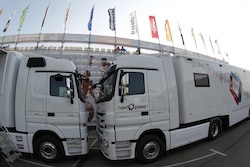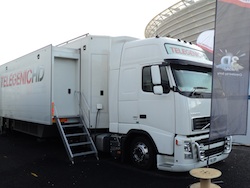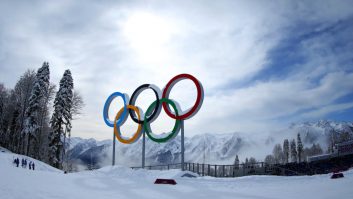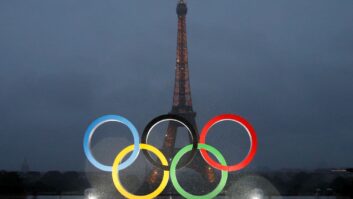
With this year’s Summer Olympics and Paralympics now over, the attention turns to the Winter Games in two years time. Planning for the Olympic and Winter Olympic Games takes around seven years.
So it was in 2007 that Sochi, in the Russian Federation, first heard that it had been chosen as the host city of the 2014 Olympic Winter Games. The same city will also oversee the XI Paralympic Winter Games, as well as the Russian Formula 1 Grand Prix from 2014 until at least 2020. In addition, Sochi will be one of the host cities for the 2018 FIFA World Cup.
So, a busy time of preparation for this Black Sea resort — and especially for those responsible for broadcasting the events from the area.
In 2009, ANO Sports Broadcasting (now better known as Panorama) was founded as an autonomous non-profit organisation by Russia’s Channel One, VGTRK, NTV-PLUS and the RIA Novosti news agency for the purpose of providing live national television coverage of the Winter Olympics and Paralympic Games. As part of the company’s preparations for those events, a number of important steps have taken place.
First, in 2010 12 outside broadcast units – a mixture of 10, 16 and 24-camera capacities — were ordered from Sony in the UK and Germany. Most of these have now been delivered and are being used for a variety of OB work for different customers.
Alongside those OB units, acceptance tests were made in July on a new Mobile Master Control Room (MMCR) being built in Germany. This vehicle will be used to integrate the output from the Sony OB vans and other sources, and combine them into one production unit. “Broadcast Solutions in association with ISPA-SAT in Russia is building the vehicle and installing the equipment,” explains Sergey Podlesskii, Panorama’s CTO (head of Production Technology).
The MMCR consists of two OB trucks measuring 16.5 metres in length and 2.55 metres wide. The main MCR has two expandable walls and can accommodate 15 staff. The auxiliary vehicle has one expandable wall and includes 12 workstations.
This auxiliary van can also be used as a scanner, if necessary.
“The truck contains equipment in flight cases. It consists of eight Sony HDC cameras, a Snell Kahuna 360 video switcher, router, glue, Studer Vista 5 M2 audio mixer, processing and monitoring equipment,” reports Podlesskii.
Editing in the MMCR will be carried out using IP Director, while Riedel will provide the communications system. “The uplink is built into the Auxiliary truck. It consists of a 2.4 metre uplink antenna, two 400 Watt HPAs with phase combining, two encoder/modulators, five IRD and six comms modems,” states Podlesskii.
Nationwide applicants
The second stage of preparation for the huge influx of OB work involved a massive training programme to ensure enough experienced personnel were available for the 2014 games.
“We started the training programme in May 2011,” explains Vasily Kiknadze, CEO of Panorama. “Applications came in from all areas of Russia, but because of the size of the country our first interviews were conducted by telephone and Skype. We were able to select between 50 and 60 people from each region to come to Moscow for initial training.”
Kiknadze says that the first course involved mostly theory, but also covered some practical work. However, because this training was begun prior to the delivery of the first Sony vehicle, a simulated OB van was used for hands-on demonstrations.
“We received a great deal of help from the vendors of the equipment that we would be using. After two weeks of 10-hour working days, we were able to determine who of our trainees were suitable to continue with the subsequent courses.”
Once the outside broadcast vehicles started arriving in Moscow, they were used for the ongoing training programme using the technology installed for live productions. When the formal training is completed, those who pass will receive state-recognised advanced training certificates — and Panorama will then have a large number of specialists who can be employed. One of the first productions, using a 10-camera unit, involved the inauguration ceremony of the Russian President Vladimir Putin.
In the first part of July, training was switched to a 16-camera truck. On 12 July, the students took their final examinations, presided over by Panorama’s technical experts, alongside faculty from the Moscow State Institute of Radio Engineering, Electronics and Automation.
To complete that session of training, the trainees covered the Moscow Beach Football Championship at the Yantar arena in Strogino using one of the new 16-camera OB units. At the same time, another crew took part in covering the Moscow City Racing Formula 1 exhibition race using another 16-camera van and additional TV equipment.
From 22 September until 13 October, the FIFA U-17 Women’s World Cup 2012 takes place in Azerbaijan. Multilateral feed of all 32 matches will be produced for a worldwide audience by Panorama using three OB vans and three SNGs.
“These are all tremendous training experiences,” states Kiknadze.
Of course, there is the question of what will happen to such a huge workforce after the needs of the 2014 Games have been fulfilled. Will there be enough work to keep the trained staff employed?
“We cannot predict the future,” admits Kiknadze. “But once the Games are over, many of the OB trucks will be deployed in various regions around the country and there will be a requirement for them to be in the hands of experienced personnel. In addition, Russia is going through the transition to digitalisation – and there will be people who are going to be in a position to help with that change.”
Practical preparation
The final stage of the preparation for Sochi 2014 involves using the OB units in a variety of sporting events and venues as live rehearsals. This allows the trainee personnel to work alongside experienced crews in readiness for events that will be covered in Sochi.
That specific preparation for the winter sports first took place in February when Panorama produced an HD signal for the first live Russian TV broadcast from alpine skiing competitions. “Never before had we broadcast from Olympic facilities, and never before – neither in the Soviet Union, nor in Russia – had we broadcast live from alpine ski competitions. We went into unknown territory, and that’s what is most difficult and most interesting,” states Kiknadze. He says that, in all, 16 test competitions that take in all Olympic disciplines will be covered in the next six months.
So, with the focus shifting from the summer games of 2012 to the winter Olympics in two years, what lessons has Kiknadze learned from the recent experiences in readiness for 2014? “I think there are several areas that are important. First, the planning of such big events takes a great deal of time. Deadlines come and go far more quickly than you expect.
“Next, on the technical level, we will continue our training programme to include the new technology that we are going to employ in Sochi. And finally, producing a national signal on the scale that we anticipate for Sochi requires considerable thought and coordination with Olympic Broadcasting Services (OBS).”
By Philip Stevens
www.panoramahd.ru
www.sony.co.uk
www.broadcast-solutions.de
www.snellgroup.com
www.riedel.net
www.studer.ch







